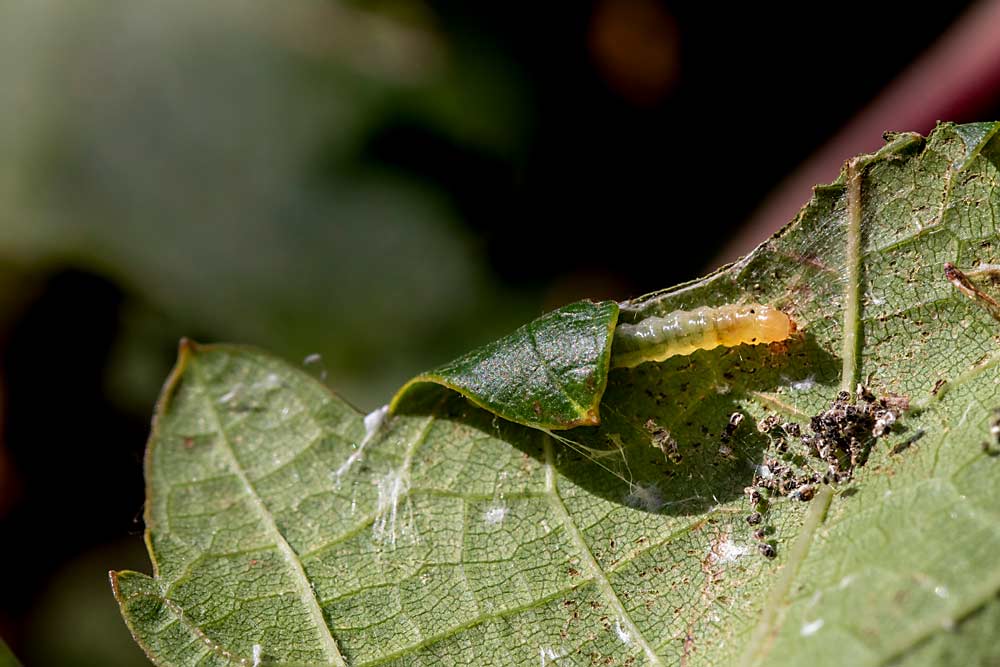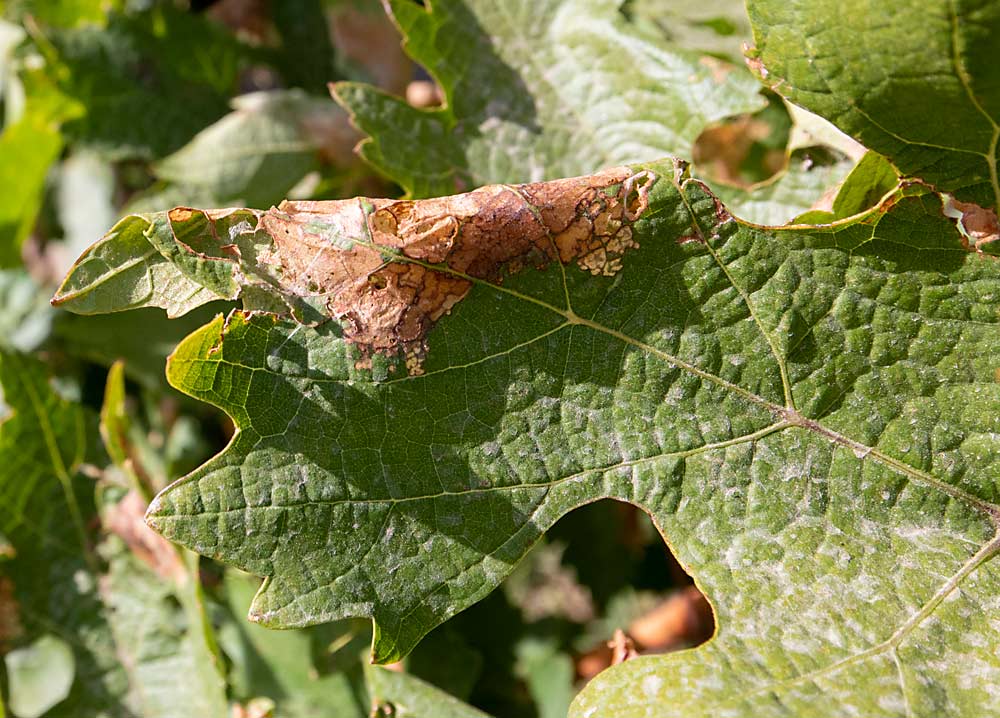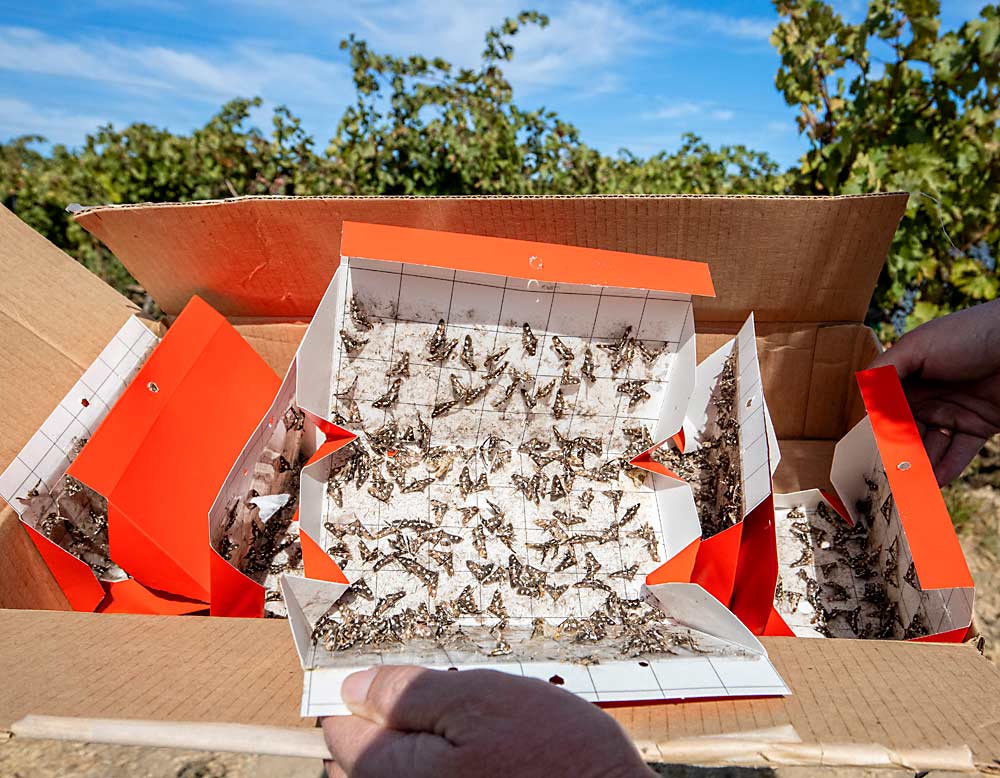
Researchers identified a new pest hiding in the folds of leaves in Washington vineyards: the white-headed grape leaffolder, which is distinct but closely related to the California leaffolder found in California vineyards. So far, the leaffolder has only been found in vineyards in the Red Mountain, Mattawa and Tri-Cities areas. (TJ Mullinax/Good Fruit Grower)
Several years ago, growers on Washington’s Red Mountain began to notice folded leaves in the vineyards, indications that a new pest was making itself at home. Feeding by the caterpillars, which create leaf folds to hide from predators, caused severe defoliation in some new plantings, and growers worried that it might delay ripening in mature blocks.
So, with support from the Washington Wine Commission, entomologist David James launched a survey last summer to identify the pest and assess its distribution, life cycle and potential for biological control.
“We assumed that this was the California leaffolder. It’s been a pest in vineyards for decades,” said James, who is based at the Washington State University Irrigated Agriculture Research and Extension Center in Prosser. “But it’s not. It’s a closely related species called the white-headed grape leaffolder.”
James’ team recorded the first identification of Desmia maculalis in Washington and found no Desmia funeralis, the leaffolder that’s well known in California. The caterpillars of the closely related species look very similar, but the white-headed moths have distinctive black and white spots, James said.
He found it in vineyards around the Tri-Cities, Mattawa and Red Mountain in South Central Washington.

Evidence of caterpillar feeding and a telltale leaf fold indicate that the white-headed grape leaffolder is present. (TJ Mullinax/Good Fruit Grower)
“It’s probably been here all the time but was never recorded,” James said, adding that it’s also been documented in British Columbia. “We’re the first example of it causing economic damage in grapevines.”
Growers dealing with outbreaks of the leaffolders tried pheromone traps designed for the California leaffolder. At first, they seemed to work, James said, catching dozens or even hundreds of moths that he then identified, but as the season continued, efficacy waned.
“Because it’s not the same species, this pheromone doesn’t work very well. If there are enough female moths around, then the males respond to the females,” not the traps, James said. “By the autumn, when the populations are the highest, (the traps) weren’t catching any, and that’s presumably because lots of females were out.”
Developing a pheromone specific for this leaffolder would be expensive and unlikely, given its damage is localized to one region of Washington.
Instead, James plans to test out baits for the moths this year, using things such as molasses and syrup, just as California growers did a generation ago, before pheromone traps.
He also wants to better understand the leaffolder’s behavior and natural enemies. The California leaffolder has several generations a year, but James was surprised to find that the white-headed leaffolder doesn’t seem to reproduce quickly in the heat of the summer.
“They seem to stop and go into like hibernation, but for summer dormancy the word is aestivation,” James said. “It’s something a lot of insects do when it’s too hot in our climate. Then they wake up, if you will, in September and get on with it.”
That could make it easier to manage this pest — say, if one June insecticide spray combined with the summer heat can keep populations in check. But researchers need more than one year of data to really understand the leaffolder’s life cycle in the region.

Allyson Leonhard, a research technician with Washington State University, shows off white-headed grape leaffolder moths caught in traps using a pheromone lure designed for the California leaffolder. But the efficacy of the lure appears to wane through the season, entomologist David James warned, as it’s not a perfect fit for the pest found in Washington. (TJ Mullinax/Good Fruit Grower)
So far, it appears that lots of the natural enemies present in Washington’s vineyards will target the leaffolders, including parasitic wasps and predators such as spiders and earwigs.
When the signature leaf folds are unfolded, only about a quarter were found to have the caterpillar inside, James said. Since they only create two folds in their lifetime, these missing caterpillars suggest that spiders and other crawling predators have snuck in and eaten them.
That’s another theory James aims to investigate further this summer.
As for insecticides, understanding the susceptible points in the leaffolders’ life cycle will be key, so that they can be controlled with softer, targeted products.
“We don’t want to use something heavy and cause bigger problems with mites and mealybugs,” James said. “It’s important that we come up with a strategy that minimizes disruption” to a vineyard’s existing IPM.
The leaffolders have not shown much dispersal in the past few years, James said, but he urged wine grape growers around the state to contact him if they find the telltale folded leaves. •
—by Kate Prengaman






Leave A Comment